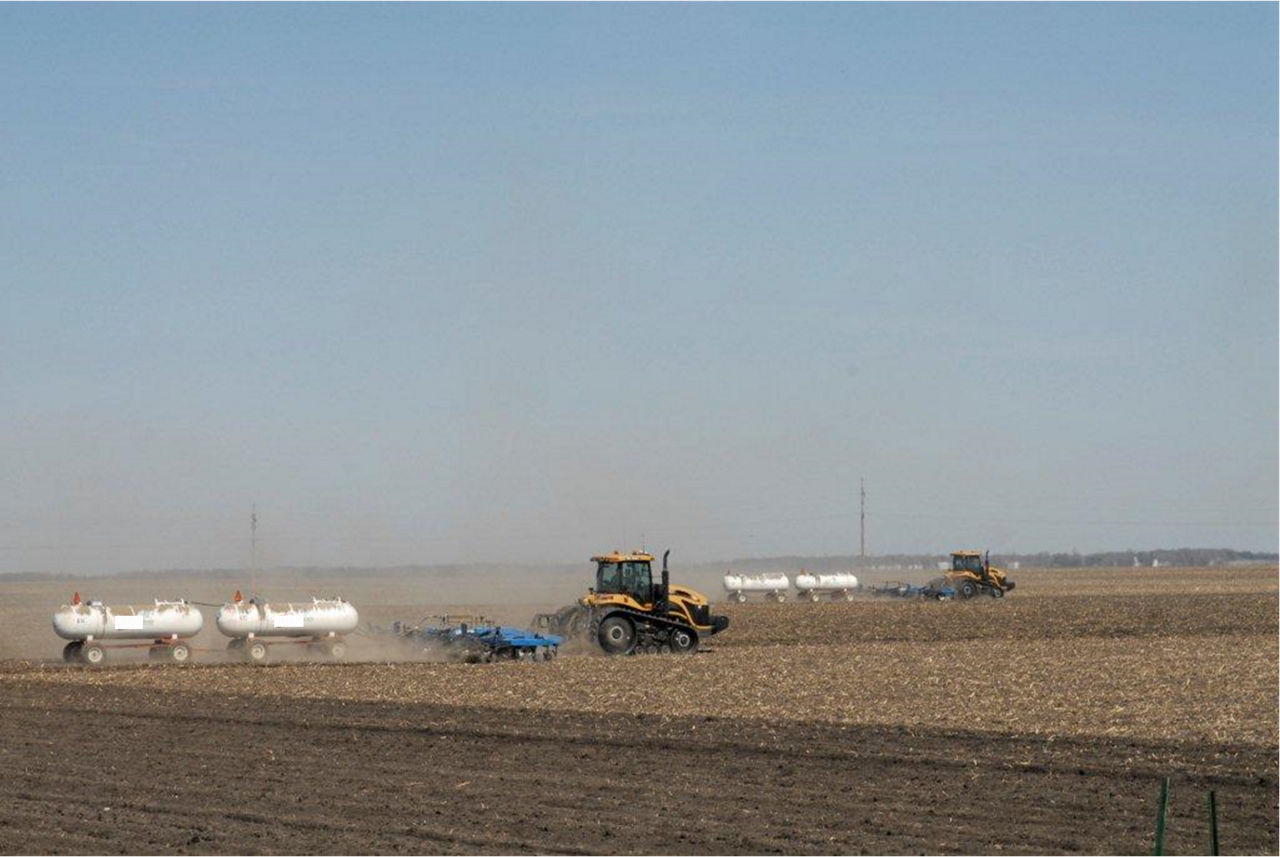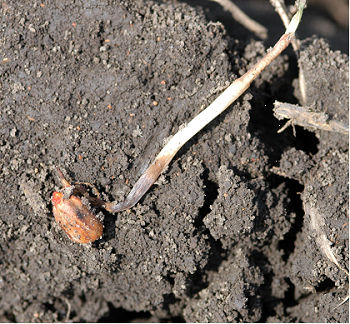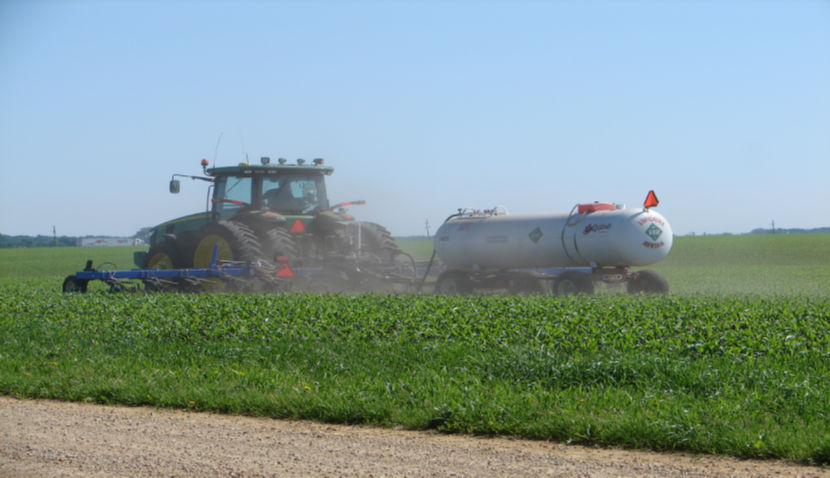3 MIN READ
Fall and Spring Anhydrous Ammonia Applications
April 15, 2024
Introduction
According to Emma Orchardson of CIMMYT (International Maize and Wheat Improvement Center) “Nitrogen is the most essential nutrient in crop production but also one of the most challenging to work with”.1 This is why it is important to start with nitrogen (N) when considering a crop fertility program and consider more than the application rate. The 4 R’s of crop nutrition (the right source, the right rate, the right placement, and the right timing) should be considered for a crop nutrition program.2 Anhydrous (contains no water) ammonia (NH3) is a widely used N fertilizer source for crop production. Due to its unique properties, there are important characteristics and safety precautions that should be understood and followed. Characteristics and precautions include:
- NH3 is a toxic gas that is stored as a liquid under high pressure.
- If inhaled, NH3 vapor can cause severe respiratory injury.
- NH3 can cause freeze and chemical burns if the liquid or vapor encounters the eyes or skin.
- Special protective equipment (PPE) for eyes and skin must be worn when handling or working on or around NH3 application equipment.
- NH3 requires specially designed and well-maintained storage, delivery, and injection application equipment.
- Anyone working around or applying NH3 must be trained to follow exact handling procedures.
While it is understood that NH3 is a very hazardous substance, it can be a cost effective and easy to apply N source for crop production when handled and applied properly. Because of the chemical properties of NH3, it is the preferred N source for a fall application and is also a viable N source for a spring application. Anhydrous ammonia, which is 82% N, is often the least expensive N source because most of the other N sources start with NH3. It takes several chemical manufacturing processes to change NH3 into other dry or liquid N fertilizer sources, all of which have a lower N concentration. The cost per pound of the lower N concentration products, delivered to the farm, over NH3 often increases because of the additional chemical processes and the increased transportation cost per ton of N.
Chemical and Physical Properties of NH3
Anhydrous ammonia, a pressurized liquid that turns immediately into a gaseous form when injected into the soil, quickly reacts with soil water to form ammonium (NH4+). This is why NH3 is injected below the soil surface where it binds tightly to the soil. Once injected into the soil, NH3 takes about a day to diffuse and expand into a 3- to 4-inch (7.6 to 10.2 cm) diameter cylinder around the injection point. This concentrated zone can be larger in sandy or in extremely dry soils. The rapid soil binding is due to the affinity NH3 has for soil moisture where it picks up an additional hydrogen ion to convert it to NH4+. With the positive charge, NH4+ is attracted to negatively charged soil particles which keep it from moving with soil water. When NH4+ goes through nitrification, which is caused by bacteria in the soil, it is converted to nitrate (NO3-) and loses its positive charge. With the loss, NO3- becomes mobile or able to move with water through the soil profile and N can be lost as nitrate via leaching (movement of N below the roots with soil water) or by denitrification (the microbial process of reducing nitrate and nitrite into a gaseous N form in water saturated soils). These gaseous N forms can now be lost to the atmosphere and are not available for plant use. When compared to other N fertilizers, the rate of conversion of N to NO3- in the soil is slower with NH3, helping to minimize the potential for N loss. Warm temperatures and wet soils can speed up the nitrification process.3
Fall Application
A fall NH3 application is often appealing because it is usually lower in cost, there can be more time for application, and soil conditions are often better for injection (Figure 1). Fall applications can also help reduce soil compaction and spread out the workload for more timely spring planting. Success of fall applications can be increased by applying when soil temperatures drop below 50 °F (10 °C) at the 4-inch (10 cm) depth and with continuing cooler conditions forecasted. Including a nitrification inhibitor along with NH3 and injecting it into fields with adequate drainage (do not remain wet or fields with excessively coarse or very sandy soil types) can also help reduce N loss.

A nitrification inhibitor, which delays the process of NH3 being converted to nitrate by the naturally occurring soil bacteria, works best when soils are at or below 50 °F. The NH4+ form of commercial N is the only form that is tightly bound to soil particles; therefore, maintaining the N in the NH4+ form as long as possible helps lessen the possibility of N loss via NO3- leaching or denitrification.
Splitting Fall and Spring Applications
If conditions are not ideal for a fall application (warm soil temperatures extending into late fall or wet soil conditions), the window for injection may be very small. Therefore, having an alternative plan that may include split N applications may be beneficial. A potential solution may be a fall application on the fields best suited for N retention and delaying the application until spring on fields where NH3 is not well suited. Splitting applications in the fall and spring can help minimize many of the disadvantages associated with a single large fall or spring application by applying a lower rate in both the fall and spring. Applying some NH3 in the fall can provide what the crop needs to get started in the spring. Applying the remainder in the spring, closer to when the plant needs the N, helps to increase efficiency, and reduce the potential for loss by leaching and denitrification.
Spring Application
Anhydrous ammonia can be and is often applied in the spring. Spring applications can help to limit N loss before it is needed by the crop. However, if the planting window opens soon after injection there are some factors that should be considered, as there can a be high concentration of NH4+ close to or in the seed slice that can potentially injure seeds and seedlings. Factors include:
- High soil moisture can cause excessive odor as the NH3 escapes from an open slice during application. The equipment should be adjusted to move more soil over the application slice, or delay application until soil conditions improve.
- Inject the NH3 at a depth of at least 6- to 8- inches (15 to 20 cm), and make sure soil conditions allow for an adequate amount of soil to seal over the injection point. When soil conditions are dry, particularly in coarse soils, NH3 can move through the soil. Under cloddy conditions it is possible for the NH3 to move up the soil profile and escape.
- The use of a sealer attached to the knife can help close the injection opening, and under no-till conditions a coulter in front of the knife may assist in making an opening so that it closes more completely with the use of a sealer.
- Delay planting to reduce the possibility of seed or seedling injury.
- Seedling damage by NH3 can result from:
- Injury from the gaseous state that has not reacted with the soil moisture soon after injection.
- Very high soil pH following NH3 injection.
- Fertilizer salt damage.
- Injury symptoms appear as blunt root tips with a black or brown burnt discoloration (Figure 2). Emerged plants may appear stunted and may have a purple or reddish-tint or have a drought stressed look. Severely injured seedlings may die before emerging and result in a skip in the stand.4
Note. The different types of damage caused by the different causes can look very similar but the potential for seedling stunting or death are the same.

Strip-till NH3 Application
Injecting NH3 via strip-till, which can be done as a fall or spring application, brings its own set of application concerns. As with most strip-till NH3 applications, the seed is placed directly over the NH3 injection point. While strip-tilling allows for the precision placement of a fertilizer band directly below the seed, which can increase the fertilizer use efficiency especially in low fertility soils, the concern is the germinating seed could be in a concentrated N fertilizer zone that can negatively affect germination and early growth (fertilizer burn).
There are no hard-set rules when to strip-till NH3 in the spring or fall, but the injection point should be 7- to 8- inches (17.8 to 20.3 cm) deep with some situations that could require an application depth of up to 10 inches (25.4 cm). Injection timing should be at least three to four weeks before corn planting; however, depending on many variables, it could require more time before planting. The variability includes NH3 rate, soil moisture, soil organic matter, soil condition, soil type, weather, and the amount of soil moved over the seed slice at planting, all of which can affect the N concentration in the seed germination zone at germination and during seedling growth.
The potential for seed or seedling injury can be huge if planting occurs soon after injection, if the soil is very sandy or dry at the time of a strip-till injection and the NH3 rate is high. The one hard-set rule that should be adhered to is not reducing the depth of the strip-till injection point when the tractor horsepower is not adequate to pull the strip-till application rig at the desired depth due to tough or hard soil conditions. The reduced injection depth along with poor soil conditions can increase the potential for loss of germination and seedling injury that may require the crop to be replanted. Your local seed representative or agronomist should be consulted to assist with strip-till management strategies for your area.
What can be done to minimize the possibility of anhydrous ammonia crop injury?
There is no specific amount of time in which fall, or spring applied NH3 no longer has the potential to injure the crop. If planting needs to occur soon after application, recommendations to consider include:
- Not planting directly over the injection opening can help reduce the risk. If the planter is equipped with GPS technology, the planter unit can be offset by at least four inches or more, so the seed is not planted over the injection opening. If it is off set considerably, planting can occur on the same day as injection with minimal risk of injury.
- Reduce the NH3 injection rate or narrow the spacing of the knives to lower the ammonia concentration at a single point. Any moisture that follows an NH3 application helps reduce the concentration of the N in the retention zone.
- Consider applying NH3 as a sidedress (Figure 3). For sidedress applications, a safe distance from the growing plants and developing roots should be maintained to help limit the potential for crop injury.
- Using an alternative N source, that may cost more, for spring applied N may be the best solution if conditions are not conducive for an NH3 injection.

Sources
1Orchardson, E. 2020. Nitrogen in agriculture. CIMMYT. Nitrogen in agriculture. https://www.cimmyt.org/news/nitrogen-in-agriculture/
2Rogers, E. (Fronczak, S.) 2019. The 4R's of nutrient management. Field Crops. Michigan State University Extension. https://www.canr.msu.edu/news/the-4r-s-of-nutrient-management
3Sawyer, J. 2019 Understanding anhydrous ammonia application in soil. ICM News. Integrated Crop Management. Iowa State University Extension and Outreach. https://crops.extension.iastate.edu/cropnews/2019/03/understanding-anhydrous-ammonia-application-soil
4Maharjan, B., Iqbal, J., Puntel, L., and Rees, J. 2023. Fertilizer-nitrogen injury to corn. CROPWATCH. University of Nebraska- Lincoln. https://cropwatch.unl.edu/2023/fertilizer-nitrogen-injury-corn
Web sources verified 4/3/24. 1213_103341